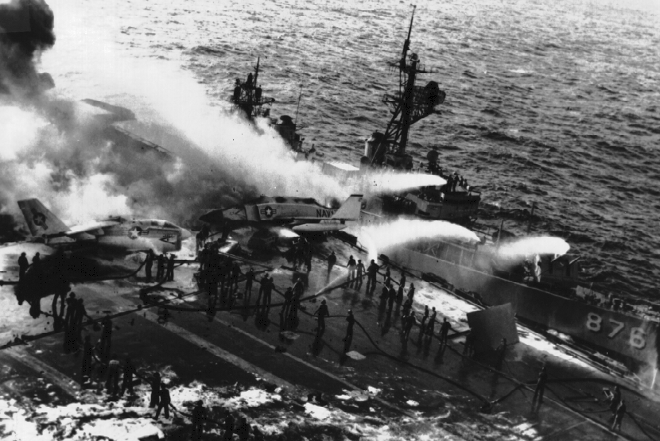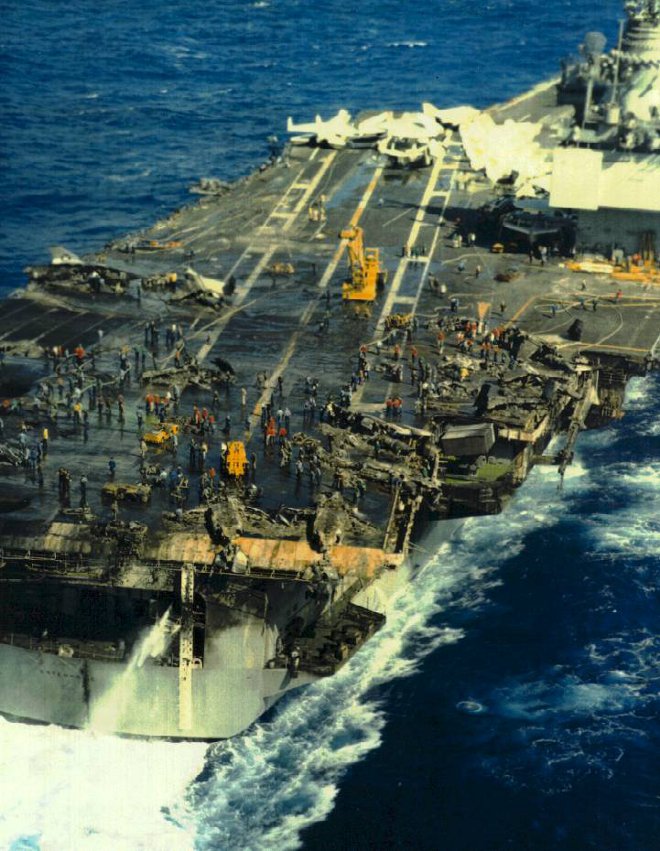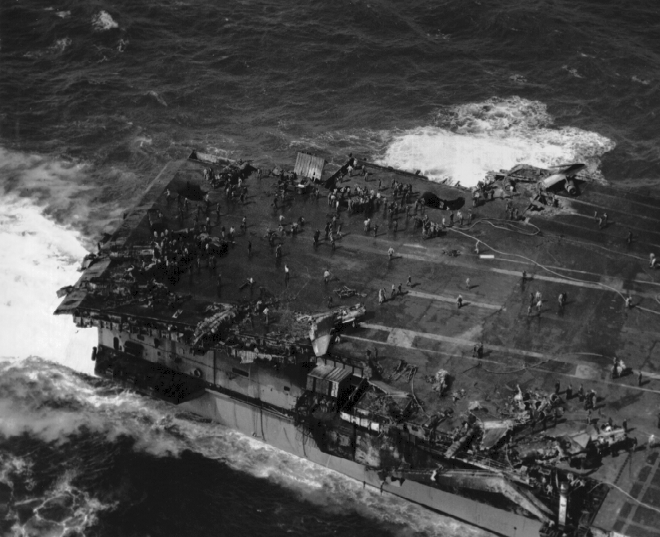On 14 January 1969, there was another aircraft carrier flight deck fire. This one occurred aboard the aircraft carrier USS ENTERPRISE (CVAN-65) as she was sailing in the Pacific Ocean about 70 miles south west of Pearl Harbor.
USS ENTERPRISE (CVAN-65) 15 January 1969. Fire and munition explosions. USS ROGERS (DD 876) helping contain the fire. U.S. Navy photo
The exhaust heat (about 850°F) from an aircraft engine-starting unit (an MD-3A “Huffer”) was inadvertently directed onto a pod containing four 5-inch ZUNI rockets hanging under the wing of an F-4J aircraft. The heat caused one or more of the warheads to detonate in the pod. Each warhead contained about 15 pounds of Composition B. Unlike the accident aboard the USS FORRESTAL (CVA-59) in July 1967, the ZUNI rockets did not launch and strike another aircraft on the flight deck. Rather, the trigger event here was the “cook-off” of the Composition B explosive charge in the warhead.
The explosion of the ZUNI warheads in the pod ruptured the aircraft’s fuel tanks and ignited the JP-5 fuel. Less than one minute after the fire started, three ZUNI warheads in the pod under the port wing detonated. The warhead shaped charges blew three holes through the flight deck. This allowed burning fuel to pour into the next lower level.
USS ENTERPRISE (CVAN-65) – Aftermath of fire and munition explosions. U.S. Navy photo
The first bomb engulfed in flames under the F-4 detonated about 3 minutes after the initial ZUNI warhead explosion. The blast blew an 8-foot by 7-foot hole through the flight deck and debris punched holes through the decks below. The following is taken from a book written by a sailor who was an eyewitness to this disastrous event:
“The heat of the explosive burst the 03 level aflame and shortly, burning JP-5 fuel poured down through, draining from the flight deck and fired the 02 and 01 level compartments … and began leaking down onto the main deck. …everyone was stunned by the explosion and the shrapnel that hit all about the island…. Both twin agent units were knocked out. Hoses flopped about wildly, geysering spumes of foam and salt water. Men were on fire, the wounded moved feebly, the dead were still….”21
Determined fire fighting restricted the fire on the flight deck to an area aft of the island and away from the ammunition holding areas. Some 40 seconds after the first bomb detonated, another MK-82 bomb exploded cratering the flight deck. This event was immediately followed by the more violent detonation of the third 500-pound bomb.
Several more explosions or munition detonations followed. One of the more serious munition reactions occurred some two minutes after the detonation of the third bomb. A bomb rack holding three MK-82 bombs detonated next to a fuel tanker aircraft loaded with 6000 gallons of JP-5. The detonation created a 22-foot by 18-foot hole in the deck. The fuel leaking from the tanker created a huge fireball that swept the deck and spread the fire.
USS ENTERPRISE (CVAN-65) – View of damage after the fuel fire and munition explosions. U.S. Navy photo
In all, there were 18 munition explosions or detonations. Eight holes were blown through the flight deck and deep into the ship. It took in a little over three hours to extinguish all of the fires. This incident resulted in 28 deaths and 344 injuries. There were 17 aircraft damaged and 15 destroyed. The cost of repairing the structural damage to the ship and replacing the aircraft and other equipment was over 126 million dollars.
The effects of this latest aircraft carrier disaster was still being evaluated by the Services when, on 23 March 1969, a Viet Cong sapper team attacked the U.S. ammunition storage area in Qui Nhon, Vietnam. Fire and secondary mass detonations of munition stacks resulted. Three persons were killed, 34 were wounded, and many tons of Army, Navy, Marine Corps, and Air Force munitions were destroyed.
A little more than a month later, on 27 April 1969, the ammunition dump at Da Nang, Vietnam was destroyed by fire and the secondary mass detonation of munitions. Some estimated that the loss of ammunition at Da Nang cost the U.S. in excess of 123 million dollars. Following these two incidents, the Army bolstered its research on ways to pack munitions to avoid mass detonations in storage areas; however, TNT, Composition B and Octol (HMX and TNT) remained Army’s explosives of choice for munitions.
21Carlin, Michael Joe, TRIAL Ordeal of the USS Enterprise 14 January 1969, Tuscara Press, West Grove, PA 19390, 1993.


